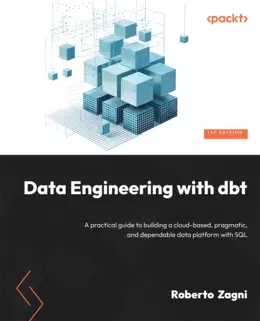Data Engineering with dbt

eBook Details:
- Paperback: 578 pages
- Publisher: WOW! eBook (June 30, 2023)
- Language: English
- ISBN-10: 1803246286
- ISBN-13: 978-1803246284
eBook Description:
Data Engineering with dbt: Use easy-to-apply patterns in SQL and Python to adopt modern analytics engineering to build agile platforms with dbt that are well-tested and simple to extend and run
dbt Cloud helps professional analytics engineers automate the application of powerful and proven patterns to transform data from ingestion to delivery, enabling real DataOps.
This book begins by introducing you to dbt and its role in the data stack, along with how it uses simple SQL to build your data platform, helping you and your team work better together. You’ll find out how to leverage data modeling, data quality, master data management, and more to build a simple-to-understand and future-proof solution. As you advance, you’ll explore the modern data stack, understand how data-related careers are changing, and see how dbt enables this transition into the emerging role of an analytics engineer. The chapters help you build a sample project using the free version of dbt Cloud, Snowflake, and GitHub to create a professional DevOps setup with continuous integration, automated deployment, ELT run, scheduling, and monitoring, solving practical cases you encounter in your daily work.
- Create a dbt Cloud account and understand the ELT workflow
- Combine Snowflake and dbt for building modern data engineering pipelines
- Use SQL to transform raw data into usable data, and test its accuracy
- Write dbt macros and use Jinja to apply software engineering principles
- Test data and transformations to ensure reliability and data quality
- Build a lightweight pragmatic data platform using proven patterns
- Write easy-to-maintain idempotent code using dbt materialization
By the end of this Data Engineering with dbt book, you’ll be able to build an end-to-end pragmatic data platform by ingesting data exported from your source systems, coding the needed transformations, including master data and the desired business rules, and building well-formed dimensional models or wide tables that’ll enable you to build reports with the BI tool of your choice.
